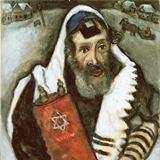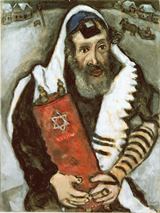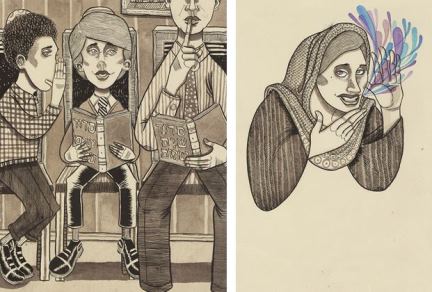
A Non-Zionist Drash of Lech Lecha
“Lech lecha me’artzecha umimoladetcha umi beit avicha...”
Now the LORD said unto Abram: “Get thee out of thy country, and from thy kindred, and from thy father’s house, unto the land that I will show thee. And I will make of thee a great nation, and I will bless thee, and make thy name great; and be thou a blessing.” Genesis 12: 1–2
Synagogues around the world divide the Pentateuch into consecutive weekly Sabbath readings, called parshat, for the chazan (cantor) to chant and the rabbi to offer a drash (reflection) on. The parshat are named for their opening words; the third parsha, read in October or early November, is Lech Lecha.

For obvious reasons, Lech Lecha has been called “the Ur-text for Zionism.” This is lost â¨on me, as nothing in my religious practice builds from commitment to Jewish nationalism or the State of Israel. I reject the idea that Jews are God’s (only) chosen people, and the “great nation” I am committed to is the USA. The significance of Lech Lecha lies, for me, elsewhere.
I am aware of few other Jewish people in my San Francisco neighborhood or at Santa Clara University, where I have taught since 1974. This is the farthest of cries from my 1950s upbringing in Boston’s Roxbury-Dorchester ghetto. Every year, Elaine MacDonald and John Mills were my only gentile schoolmates, the only kids “present” during the Jewish high holidays, two out of 600. No more diverse was the downtown garment industry where my father labored in Hymie Sherman’s factory.
All my friends and I attended Hebrew school as well as public school, and Saturday mornings we all trudged to Temple Beth El for as Orthodox a service as diasporic Judaism offered: no English spoken, males and females separated, the white-bearded immigrant congregants around me wrapped in tallitot (prayer shawls) and davening (rocking in prayerful devotion) hour after hour. And I, fidgety and impatient, eager for sunlight and baseball, breathed the room’s sentiment deep into my essence: the awe, the longing, the solemn concentration on text, the plaintive minor-key melodies before which I remain helpless to this day.
I left my kindred and father’s house to attend Boston Latin School, Dartmouth, Cambridge, Harvard, and Stanford. Between Harvard and Stanford, I taught for six years at a historically black college in Alabama, and my work at Santa Clara began at the onset of my Stanford Ph.D. studies. Past sixth grade, then, my entire public life has been spent among gentiles—a blessing, as per Lech Lecha.
Immersion in multicultural, pluralistic institutions is healthy spiritually, culturally, politically, and educationally. Get a base, a foundation, in youth; then move out, move on; expand your horizon. A liberal education like Santa Clara University’s challenges every belief, opinion, and priority that students come with, and the cumulative effect is perspective. They see their necessarily provincial upbringing afresh, through distant others’ eyes, and consciously decide what to keep, modify, and abandon. Welcoming the company of people not “their kind,” they grow in empathy, tolerance, openness of mind, and openness of heart, preparing to be men and women for others. Tribal solidarity, in sharpest contrast, prepares the young for ritualized adulthood in outposts, clans, squadrons, and mobs of the like-minded.
Teachers of technical subjects may stay hidden behind their material, but teachers in the humanities mostly offer themselves to students. The “whole student” can be educated only by the “whole professor.”
I come before Santa Clara University students, then, as an emissary from the Dorchester ghetto, channeling accents they otherwise never would hear. I channel as well my own professors—classicists, political theorists, historians, literary critics, philosophers. I speak also as a first-generation college (andâ¨high school!) student, a competitive athlete,⨠the author of a hundred-plus publications, a husband and father, a scared but not intimidated marcher over the Edmund Pettus Bridge in Selma, a wilderness hiker, a dancing maniac at a hundred-plus Grateful Dead concerts. All this is conveyed to students not as curriculum but in hints of pedagogy, class meeting by class meeting, office visit by office visit.

The "blessing" I can be for students, then, includes quirkiness, my oddness in their eyes, all the "difference" I embody and project. It says there is room for them, too, in the company of the higher educated: just apply yourself, see the beauty in your studies as well as their utility, let your studies become part of you, and you'll get there. Patently, it ís worth the effort.
The “blessing” I can be for students, then, includes quirkiness, my oddness in their eyes, all the “difference” I embody and project. It says there is room for them, too, in the company of the higher educated: just apply yourself, see the beauty in your studies as well as their utility, let your studies become part of you, and you’ll get there. Patently, it’s worth the effort.
The essence of religion as I understandâ¨it is gratitude, taking nothing for granted, including life itself. For thirty-eight years, Santa Clara University students and colleagues have inspired, uplifted, and brought out the best in me. Ambling toward retirement, I feel ever more thankful for that, ever more pleased with my choice of career, and ever braver about sharing myself. What’s to lose, really?
So I conclude by sharing what happens every Yom Kippur after our brilliant young chazan, David Cohen-Tzedek, has chanted the ineffably beautiful Kol Nidre, reducing the congregation to mush, and the Amidah prayer begins.
I stand, head down, eyes closed, woozy already from fasting, and my mind’s eye streams photographic images of my parents, beaming love toward me. Then come my uncles, aunts, cousins, and grandmother, one at a time and then all together in front of a long train of spirits crowding forward, generations of our relatives from the Old Country—Poland, Russia, and Lithuania.
I stand taller now, the great wave of spirits washing past, around, over, and through me.â¨I bask in their heat and light, but soon I feel a great pressure: the freest, least constrained of Jews, in America, its near-holy First Amendment proclaiming there can be no state religion, I live and work as the culmination of an immigrant narrative going back centuries. Somehow I—the least gifted, least heroic of men—must validate the dreams of so many oppressed, disdained, ghettoized, pogromed, rounded-up forebears.
It’s too much to handle, and I wilt. There is no other recourse available, and so I pray: “Almighty God, Adonai Elohaynu, grant me the means to be more than I am. Let my every action honor the investments made in me. Let me serve my wife, my children, my students, my country, and the world, your creation, for another year.”
I sit down, spent, but with fresh, as yet inexhaustible resolve.
JEFFREY ZORN has taught in the English Department at Santa Clara University since 1974. He attended Dartmouth College in Hanover, New Hampshire, as a classics major and did further study in Greek and Roman literature at Magdalene College, Cambridge University. He holds an MAT degree in the teaching of English from Harvard University and a Ph.D. in Philosophy of Education from Stanford University. Professor Zorn lives in San Francisco with his wife, Ann, two children Sam and Sarah, his niece Emily and nephew Hal, one yappy dog Tura, and one large, imperious cat, Shayna.